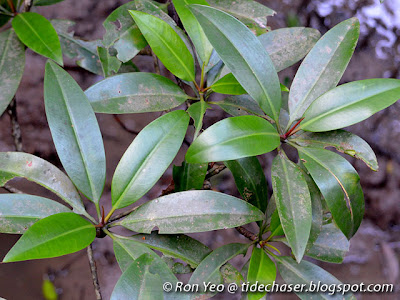The Bakau Minyak (Rhizophora apiculata) is a nationally common mangrove tree from the family Rhizophoraceae.
This rather common mangrove tree can be seen at most, if not all, of our major mangrove forests, such as Pulau Tekong, Pulau Ubin, Pasir Ris, Mandai, Lim Chu Kang, Sungei Buloh Wetland Reserve, Kranji, Khatib Bongsu, Seletar, Pandan, St John's Island and Pulau Semakau, among others.
This tree often occurs on muddy soil flooded by normal high tide, though I have seen it growing on sandy areas as well. The bark is dark grey or dark brown, and prop roots and stilt roots can be seen at the lower part of the tree. These roots help the plant breathe air, which is scarce in the waterlogged soil. The roots spread over a wide area to help stabilise the tree on the unstable ground. Like other mangrove species from the family Rhizophoraceae, R. apiculata relies on its roots to exclude salt from entering the plant through a process called ultrafiltration.
It has simple, opposite, leathery leaves that are narrowly elliptic with pointed tips, clustering towards the end of the branch. The leaf buds are thinly pointed, cover by red stipules.
Tiny black dots can be seen on the underside of the leaves, as in the case of other Rhizophora species.
The stalks of the flower heads are short, about 1cm long, and each stalk bears 2 stalkless flowers.
Vivipary is observed in this plant, as with the other mangrove species from the family Rhizophoraceae. This is a condition whereby the embryo grows and break through the seed coat and the fruit wall while still attached to the parent plant. Hence, the thin and long structures seen hanging from the trees are the seedlings, not fruits.
The hypocotyl is about 30 cm long, smooth, with a somewhat rounded tip. Mature seedlings have a red collar, and are dispersed by water. The seedling floats horizontally for a few weeks, during which the root (lower part) will absorb water and become heavier, eventually causing the seedling to tip and float vertically. As the tide goes down, the vertically-oriented seedling will sink into the mud or other suitable substrates. Most of the seedlings, however, end up being washed ashore or eaten by animals. As the seedlings are thin and long, many of them also ended up settling directly under the parent tree, as they drop and poke into the soil below.
The wood is hard and heavy, and is used for making scaffolding and furniture. It is widely used for making charcoal. This tree is often planted along fish ponds to protect the bunds.
References
- Chong, K. Y., H. T. W. Tan & R. T. Corlett, 2009. A Checklist of the Total Vascular Plant Flora of Singapore: Native, Naturalised and Cultivated Species. Raffles Museum of Biodiversity Research, National University of Singapore. Singapore. 273 pp.
- Giesen, W., S. Wulffraat, M. Zieren & L. Scholten. 2006. Mangrove guidebook for Southeast Asia. RAP Publication 2006/07. FAO Regional Office for Asia and the Pacific & Wetlands International. Bangkok. 769 pp.
- Ng, P. K. L. & N. Sivasothi. 1999. A guide to the mangroves of Singapore 1 : the ecosystem & plant diversity. Singapore Science Centre. Singapore. 168 pp.
- http://www.mangrove.my/page.php?pageid=mangrove

No comments:
Post a Comment